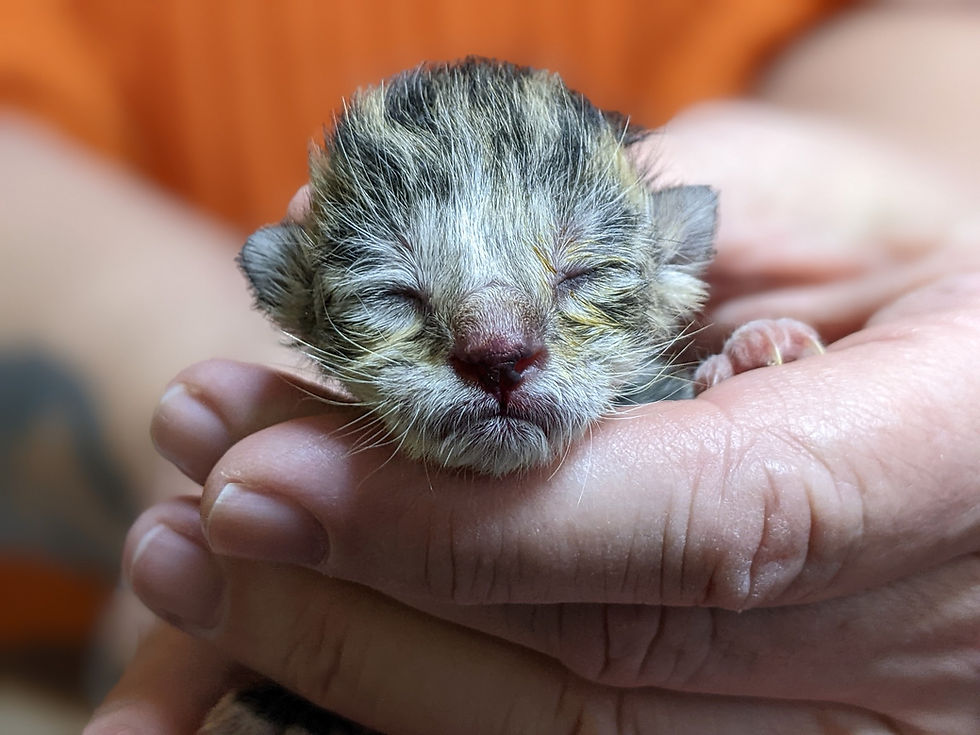What to Do When You Find Kittens Outdoors
- Kitten Alliance

- Jun 25
- 3 min read

Every spring and summer, kitten season hits — and with it comes an outpouring of well-meaning people who stumble across litters of tiny kittens outdoors. It's natural to want to scoop them up and rush them to the nearest shelter.
But here’s the hard truth: Most shelters are stretched far beyond their capacity — and bringing in kittens who don’t truly need to be rescued can actually put their lives at greater risk.
Kittens who aren’t in immediate danger may be safer where they are, at least for a short time. Many shelters simply don’t have space, staff, or foster homes to safely care for them — and euthanasia is sometimes the heartbreaking result when animals are brought in who didn’t actually need to be removed from their environment.
So how do you know what to do?
Let’s walk through the steps together.
First: Assess the Situation
If you find kittens outside, stop and observe.
Ask Yourself:
How old do they look? (See this blog: Understanding the Developmental Stages of Kittens)
Are they clean and quiet, or dirty and crying?
Is there a mother cat nearby?
💡 Tip: If the kittens are sleeping quietly, look clean, and seem well-fed, there’s a very good chance that mama cat is nearby and caring for them — even if you don’t see her.
When to Leave Them Be
You should leave kittens where they are (and monitor from a distance) if:
They look clean, appear healthy, and have round squishy bellies
They’re under 5 weeks old and not in immediate danger
They’re in a safe, dry location
You don’t see mom, but you haven’t waited and watched yet
In most cases, the best thing you can do is give mom time to come back. She’s likely off finding food — or hiding nearby, scared of you.
What to do:
Step away 30–50 feet and watch quietly for a few hours
Return later to check if they’ve been moved or fed
Don’t touch or move the kittens unless there’s danger
Mama cats are almost always the best chance kittens have for survival — especially for babies who are still nursing.
💡 Tip: If you can't stay to watch for her but can return in a few hours to check on them, sprinkle flour around the nest. That way, you'll see mom's footprints if she has returned.
When to Intervene Immediately
You should step in and take action if:
The kittens are crying constantly, cold, or covered in fleas, dirt, flies, or maggots
One or more appears injured or lethargic
You know for certain the mother has not returned after 6+ hours
They are in a dangerous location (e.g. a busy road, open yard with predators, or construction site)
The mother has been hit by a car or is deceased nearby
If you're unsure, contact a local rescue or experienced organization like ours for guidance — many groups will help you evaluate or even provide resources so you can care for the kittens yourself if necessary.
What If You Can't Care for Them?
If the kittens do need to be rescued but you can’t care for them yourself:
Reach out to a local rescue or TNR group, not just your local shelter
Ask if they have a waitlist, supply kit, or emergency foster program
Offer to be a temporary caregiver if the rescue can support you
Right now, many shelters are only taking in animals who are truly at risk. That doesn’t mean help isn’t out there — it just means we need to work together and be thoughtful about how we respond.
Final Thoughts: Be a Lifesaver — Wisely
Rescuing kittens is an act of compassion.But how and when we step in matters.
By pausing to observe, waiting for mom, and only intervening when truly necessary, you’re not only giving kittens their best chance — you're also helping shelters and rescues save the animals who need it most.
Thank you for caring.Thank you for choosing to act with love and intention. And thank you for being part of a lifesaving community.




